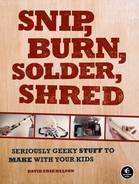As designed, this Cigar-Box Synthesizer only mixes two of the octaves that the CD4040 offers: The straight signal produced by the oscillator (the CD4093) is on pot A and is mixed with the tone one octave lower (pin 9 on the CD4040) and two octaves lower (pin 7 of the CD4040). Technically, each output on the CD4040 (pins 1 through 9, 11, and 12 through 15) is producing a fraction of the number of pulses that the chip receives on its input (pin 10). Pin 9, for example, puts out one pulse for every two that come in (thus producing a tone one octave below the input); pin 7 produces one pulse for every four that come in (i.e., two octaves below the input), and so on. Each of the remaining open pins on the CD4040 offers another signal, one octave lower than its predecessor (see the diagram in Figure 17-15). Most of the signals on the higher outputs are so slow that they register as “bonks” instead of continuous notes, but there is no reason you couldn’t add them to your mix or have them go to separate outputs via either pots (like the mixer we built in Step 7) or switches. As a rule, any time you bring several audio signals together, you want to buffer each with a 10k ohm resistor (as we’ve done on the mixer in Step 7); so if you add switches in order to bring out the bonks on pins 2 and 3 (i.e., outputs Q5 and Q6), then put a 10k resistor on the output side of the switch, and solder it to the positive leg of the 10 μF capacitor on the existing mixer.
The CD4093 likewise hides additional secrets. Look at its logical diagram (Figure 17-16), and you’ll see that its two sides are symmetrical. Rotate the chip 180 degrees, and you can build a whole separate synthesizer just like the first. Pretend pin 8 is 1, pin 9 is 2, and so on: Jumper pins 8 to 9 and 10 to 12 to 13, connect pin 8 to 10 with another 100k pot, ground pin 8 through a 0.1 μF capacitor, then run pin 11 to the tip of a jack, and—BadaBoom Disco!—you have two identical synthesizers for the price of one.
In order to shape the Cigar-Box Synthesizer’s tone (some folks find the CD4093 oscillator’s native square wave a little grating), you can add both low- and high-pass filters (there are circuit diagrams in Figure 17-17). The former filters out high tones and lets lower ones pass through, and the latter filters out low tones and lets high ones through—you are familiar with these as the treble and bass knobs on your stereo. They’re simple and go on the audio output, just before the jack.
Figure 17-17. A low-pass filter (left) and high-pass filter (right); yes, they look remarkably similar
The low-pass filter will cut the high end, which manifests itself as the characteristic square-wave sound of an early ’80s synthesizer: a reedy, fat squelch. I’ve used very high capacitor values, because the Cigar-Box Synthesizer has such an aggressive tone. These are based on classic guitar tone controls, where the caps are usually much smaller: between 0.01 μF and 0.05 μF for the low-pass filter and between 470 pF and 0.002 μF for the high-pass filters. If you decide to add low- and high-pass filters to other projects (like the Dirt-Cheap Amp in Chapter 12 or the $10 Electric Guitar in Chapter 13), you might be happier with lower values than those illustrated in Figure 17-17; start with a 0.1 μF ceramic disc capacitor (labeled 104) in the low-pass filter.
Finally, you can get rid of the pitch controller pot altogether and replace it with either a homemade ribbon controller (à la T. Escobedo’s synthstick; see “Resources” below) or your own body. For the latter, just remove the 100k pot, and mount a pair of brass knobs to the top of the box about 1″ apart, making sure the knobs and their hardware aren’t touching each other. Run a wire from pin 1 of the CD4093 to one of the knobs and another wire from pin 3 to the second knob. Grab both knobs in one hand; you won’t feel the electricity, but your skin will act as a variable resistor: Touching the knobs gently will give you a low pitch that will steadily rise as you squeeze harder.



